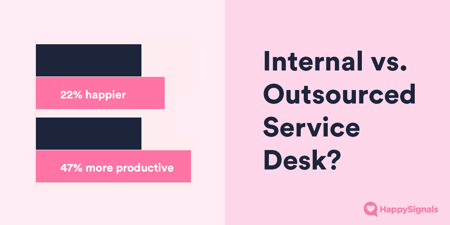The best metrics and key performance indicators (KPIs) to demonstrate IT help desk or IT service desk performance and improvement is a commonly debated subject in the IT industry. This interest is in part due to the traditional view of IT support being a “cost of quality,” where the metrics and KPIs are used to help demonstrate the business value of the IT help desk. Or at least that’s the intention, with the actual worth of the commonly used IT help desk metrics to Help Desk Managers covered in this blog post.
Please keep reading to find out more about which IT help desk metrics are most valuable to Help Desk Managers.
The common IT help desk metrics have remained constant for over a decade
Most IT help desks use the “best practice” metrics found in IT service management (ITSM) tools. These were influenced by the various versions of ITIL ITSM best practices and have been used for at least the last two decades.
The HDI “The State of Technical Support in 2023” report showed the most popular North American help desk metrics to be:
- Average time to respond (non-phone channels)
- Customer satisfaction
- Average number of tickets resolved per staff member
- Staff satisfaction
- Cost per ticket (desktop support)
- Average time to respond to desktop support tickets
- Average handle time (non-phone channels)
- Average time to resolve tickets
- Average speed to answer (phone)
- Average time to resolve desktop support tickets
But just because these are the most popular IT help desk metrics (at least in North America), it doesn’t mean that they’re the best metrics and KPIs for the needs of Help Desk Managers and their key business stakeholders. The following sections explain why.
Traditional metrics have a potentially unhealthy focus on operational performance
While all of the above IT help desk metrics have a purpose, they are similar – measuring the “mechanics” of help desk operations in terms of “how fast” and “how many.” Even the customer satisfaction score can still be “mechanics” focused, depending on the questions asked. Consequently, these popular IT help desk metrics can give a one-dimensional view of performance. Where the focus is on efficiency and not necessarily outcomes.
This operational focus is often the cause of what the IT industry has termed “the watermelon effect.” The IT help desk’s metrics show that agreed-on service-level targets have been met, but some employees are still unhappy with IT support. So, the metrics look green, but below this, there’s red in terms of the end-user perceptions of IT support performance, i.e. like a watermelon. From an end-user experience perspective, IT help desks can be measuring the wrong things and in the wrong places.
When choosing the most appropriate help desk metrics and KPIs, this is the first issue Help Desk Managers should look to address across the following three aspects:
- The level of efficiency bias – because efficiency is not a measure of outcomes, and end-users are not necessarily happy with their IT support outcomes.
- It’s a supply-side, not a demand-side, view of performance, i.e. the metrics focus on what IT thinks is most important and not what end-users think.
- The points of success measurement might be closer to the service supply than they are to service consumption.
These three issues lead Help Desk Managers toward experience level agreement (XLA) target adoption.
“But surely the cost metrics show a second dimension?”
The “cost per ticket” metric can be considered to show a second dimension of IT help desk performance. For example, when a Balanced Scorecard perspective is taken that includes the:
- Customer perspective
- Internal perspective
- Innovation and learning perspective
- Financial perspective.
But it’s a potentially dangerous metric for Help Desk Managers. For example, the average cost per ticket can drop because more tickets are being handled, not because of increased operational efficiency. In fact, the average handling time could have increased even though the cost per ticket has dropped.
Plus, the drop in cost per ticket and the ticket volume increase can be both good and bad news for Help Desk Managers and business stakeholders. The additional tickets that cause the drop could result from a worse IT performance (a bad thing) or an improved IT support reputation (a good thing).
Finally, comparing an IT help desk’s “cost per ticket” average to industry benchmarks can also be dangerous. Because the cost might not be calculated in precisely the same way. If it’s not, it’s not an “apples-to-apples” comparison and thus a misleading indicator of help desk success or improvement need.
What matters most to Help Desk Managers?
The previous two sections are intended to get Help Desk Managers thinking more deeply about the IT support metrics and KPIs they use. They would not be alone if they use a similar basket of metrics to those shared in the HDI data. After all, these are considered industry best-practice metrics.
The key to understanding the best metrics and KPIs for Help Desk Managers is starting with IT support’s objectives or desired outcomes rather than the best-practice metrics. So, what needs to be achieved by your It help desk? This should be business- and employee-focused, not simply from IT’s perspective. Only then can individual Help Desk Managers decide which metrics and KPIs are most important to them and their IT help desk. And, importantly, they need to have balance across efficiency and more value-focused measures such as XLA targets.
If you'd like to learn more about the most important KPIs for your IT help desk and how XLA targets help, please take a look at our Practical Guide to XLAs.




